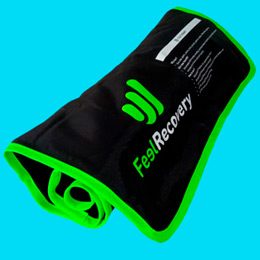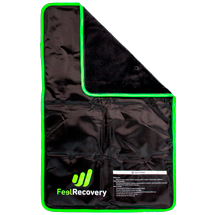- What is the best ice gel pack for shin splints and tired legs?
- Video: How to use hot and cold gel packs?
- Types of hot & cold packs you should know about
- What are the causes of tired leg pain and swelling?
- Which is better for tired legs: cold or heat?
- How to use hot & cold gel packs to reduce leg swelling?
- The best hot and cold gel packs for pain relief
Have you ever wondered why your legs hurt so much at the end of the day? If so, you probably suffer from what is called "tired legs syndrome". This syndrome is associated with a number of diseases and is much more common in women.
Although it is not a serious condition, it usually causes significant discomfort and heaviness when walking, moving your legs or standing, which affects your quality of life. Depending on the type of condition, there is a wide range of treatment options. Today we will talk about hot and cold gel packs to relieve pain in tired legs.
What is the best ice gel pack for shin splints and tired legs?
- Size: One size fits all
- Colours: Black and Green
- Material: Breathable
- No. of products: 1 Piece
- Uses: Rehabilitation and sport
- Always Flexible
- Highest Quality
- Large Size
- Soft Fabric
- Ergonomic design

Highest Quality

Soft Fabric

Always Flexible
- Large size for the whole leg
- Quality finish
- Not very flexible
To use this product and get the most out of it, just freeze it until it reaches the required temperature, then use it on the leg to stimulate the relaxation of the tissues. It does not deform with use and its flexibility allows for better support in critical areas that are often injured. As it does not restrict movement, you can use this professional cold pack at any time of the day, but you should be aware that its material is not breathable, which accumulates moisture in the leg.
- 4 Velcro straps
- Fully adjustable
- Durable cold therapy
- Includes cover
- Not very flexible
- Only one unit per order
Keep in mind that, by achieving better stability in the leg, you will avoid movements that can damage injuries, which you can combine with cold therapy. Chill the heat wrap in the refrigerator so that the capsules transmit temperature to the sensitive and strategic locations on the calf, thigh and knees. It is likely that the compression may cause discomfort and shorten the wearing time of the sessions.
- Various sizes
- Double sealed
- No adjustment of any kind
Its design and technology prevents deformation, so it adapts easily to any part of the leg in men and women. Don't miss this unique opportunity to oxygenate the muscles and relax the tendon structure to reduce fatigue and leg cramps. Place the gel sack in the freezer to obtain the necessary temperature, note that the cold retention may diminish over time.
- Optimal fit
- Protective cover
- Heat/cold therapy
- Quality finish
- Bulky design
- Short cold/warm duration
Get the medical temperature by simply placing the heating pad in the freezer for two to three hours, helping you get the therapeutic benefits without breaking the bank. Use this versatile product when training or whenever you want to relax at home, as its materials will prevent slipping down your leg. Please note that in some cases, the double stitching will give way and the internal fluid will leak out.
- Heat/cold therapy
- 2 units per order
- Finishes to be improved
It is suitable for treating symptoms of tendonitis, torn ligaments, Achilles tendon inflammation and hamstring stiffness. This is due to its ease of adaptation to the user's anatomy and the technology used to stimulate blood circulation through compression. Use the refrigerator to cool the gel or the microwave to apply thermotherapy and combine the effects of both treatments. Its fabric is not breathable.
- 2 Units per order
- Hot/cold therapy
- Not very flexible
Apply the reusable heat pack to the affected area at least three or four times a day to reduce muscle stiffness and reduce inflammation caused by the accumulation of toxins. Heat in the microwave or cool in the refrigerator for the recommended time to shorten surgery recovery times, treat arthritis, relieve patellar and Achilles tendinopathy. Consider that, in some patients, the temperature was weak for the treatment of their injuries.
Euphoria Bliss - Hot and Cold Reusable and Flexible Gel Ice Pack for Pain Relief with velcro Straps
- Material: Nylon
- Uses: Back, Shoulders, Neck, Waist and Legs
- Type of adjustment: Velcro strap
- Cover: No
- No. of units: 1
- Various models
- Fully adjustable
- Heat/cold therapy
- Suitable for pets
- Short therapy duration
- Bulky design
The adjustable strap will provide stability and compression to the joint, so the pain will also be reduced by the pressure therapy. It can be used during physical training or after a long day's work, as the feeling of fatigue and cramps disappear immediately. It can be used by anyone because its size adapts well to the anatomy of the leg, but consider that the fabric can cause irritations.
- Material: Nylon
- Uses: Knee, Ankle, Hip and Back
- Type of adjustment: Velcro strap
- Cover: Yes
- No. of units: 1
- Adjustable strap
- Protective cover
- Hot/cold therapy
- Quality materials
- Only one per order
- Only one size
You can also combine it with compression therapy because its elastic strap is anatomically adjustable to any body shape. This gives more stability and aligns the joint to generate greater support. You can use it on the ankle, calf and sole of the foot, which makes this thermal pillow a versatile health product. In some cases, the compression may be uncomfortable during use.
Video: How to use hot and cold gel packs?
Types of hot & cold packs you should know about
What are the causes of tired leg pain and swelling?
Tired legs syndrome is characterised by pain and heaviness in the legs. It is usually preceded by a day of strenuous activity that leads to non-specific pain, cramps, heaviness and swelling.
The swelling and pain are usually made worse by standing or sitting for long periods of time. Tired legs are often not due to a specific or serious condition. However, it is related to venous circulation in the legs due to peripheral venous insufficiency.
This peripheral venous insufficiency can be caused by many factors, of which the following can be mentioned:
- Hormonal changes: Hormones play an important role in the lymphatic system. The hormonal changes that occur during the menstrual cycle can lead to increased fluid retention. This fluid retention can accumulate in the lower parts of the body, such as the legs.
- Heredity and age: Heredity plays a very important role in many diseases, including venous insufficiency. As long as there are direct relatives who have the condition, it is more likely to develop over a lifetime. In addition, as the years go by, the tissues become weaker and the likelihood of developing vascular pathologies increases.
- Lack of exercise: Without physical activity or sport, the leg muscles do not do their job of supporting circulation. Walking, jogging or sports promote venous return and thus relieve the feeling of heaviness in the legs.
- Diet and bad habits: Bad habits in general can lead to cardiovascular problems that can promote peripheral venous insufficiency. A poor diet encourages the development of obesity and overweight. Carrying more weight than is appropriate for your height invariably leads to tired legs syndrome.
- Smoking: Tobacco or cigarettes contain toxic substances that damage the vein walls. These substances affect the valves of the veins in the medium and long term, which directly affects the blood flow in the legs.
- Excess sodium and potassium deficiency: This is caused by a diet high in salt and low in potassium. This leads to increased fluid retention, which is a compensatory mechanism of the body to maintain water and electrolyte balance.
- High ambient temperatures: High ambient temperatures cause dilation of the blood vessels, especially the veins in the legs. This can cause blood and fluid to pool in the lower limbs, leading to increased heaviness and swelling.
Which is better for tired legs: cold or heat?
Tired legs syndrome can be treated in several ways to relieve the symptoms. The first is to avoid standing or sitting for long periods of time, especially in summer because of the intense heat. It is important to exercise, such as running, so that the muscles can pump out excess fluid and blood.
People with advanced peripheral venous insufficiency can be helped by wearing compression stockings. These stockings are also called compression socks because they reduce swelling and improve venous return. To keep the muscles and veins working well, you should avoid tight clothing. In some cases, pharmacological treatments are needed to improve blood flow to the lower limbs.
However, first find out about the benefits of each:
Benefits of cold
Cold is an excellent anti-inflammatory and analgesic used for acute inflammatory processes. Nevertheless, the benefits of the therapy can be maximised if it is used in combination with thermotherapy:
- Pain relief: Applying cold compresses or gel packs to the legs causes a blockage of the peripheral nerve endings. This prevents the transmission of pain impulses and thus leads to pain relief.
- Strong anti-inflammatory effect: The local cold constricts the blood vessels in the affected area and thus reduces the blood flow. This prevents the release of pro-inflammatory substances and damage to the adjacent tissue.
- Tissue recovery: Long-term tissue damage is caused by poor circulation in the lower limbs. Cold prevents cell damage, the invasion of repair cells that increase inflammation, and allows soft tissue to recover.
Benefits of heat
Heat is also very useful in improving blood circulation to the lower limbs. Some of its benefits are as follows:
- Vasodilatation: Heat causes vasodilatation in the leg veins. This increases blood flow, which enables a better supply of oxygen and nutrients to the adjacent soft tissue.
- Relaxing effect: Thermotherapy is excellent for relaxing the muscles of the lower limbs. This is very important, especially for muscle tension due to fatigue.
- Pain relief: due to the improved oxygenation of the tissues and the associated relaxing effect, which allows for rapid pain relief.
- Improved well-being: The application of heat to the leg muscles has a relaxing effect that leads to a greater sense of well-being. Heat therapy also reduces stress levels.
How to use hot & cold gel packs to reduce leg swelling?
These combined therapies are called contrast therapies, which are done with water in buckets. Since not all parts of the body are suitable for the use of buckets, new alternatives, such as gel packs, have been developed. This requires two bags filled with gel, one for heating and one for cooling.
Heat Therapy
Heating gel packs is very easy, you can use a microwave or a water bath. You need to be extra careful when heating as our products are not intended for hot use. However.
If you follow these tips, you can heat them successfully:
- When heating in the microwave, the power is set to 800 W for 30 seconds.
- It is necessary to check the temperature by touching and massaging the bag so that the heat is evenly distributed.
- Ideally, the temperature should be between 38 and 44 degrees Celsius. This is the perfect temperature to heat the fabrics without reaching the focal point.
- If it is not hot enough, you can put the gel pack back in the microwave and heat it for another 10 seconds.
- If it gets too hot, it is best to leave it at room temperature for a few minutes. When it reaches the ideal temperature, it is ready to use.
- If you don't have a microwave, you can heat it in a water bath by bringing 3.5 litres of water to the boil in a saucepan.
- When it has boiled, turn off the heat and place the gel pack on top.
- Wait for 8-10 minutes and remove the gel pack from the hot water. Use blunt tweezers so as not to damage the gel pack.
- Dry the gel pack thoroughly so that it can be used.
Cold Therapy
This process is also very simple, here are the recommendations for cooling the gel pack properly:
- The gel pack should be placed in the freezer or refrigerator at least 2 hours beforehand.
- The optimal temperature of the gel pack should be between 10 and 20 degrees Celsius for the therapy to work properly.
- Once the 2 hours have passed, remove the gel pack from the freezer and use it.
Hot & cold therapy
The correct method of this therapy is to alternate temperatures to achieve the correct activation of the cardiovascular system. The application of heat followed by cold causes vasodilation and vasoconstriction, which improves blood and lymph circulation. This significantly reduces pain, swelling and oedema.
The correct procedure for performing contrast therapy is as follows:
- First place the warm gel pack on the legs for 5-8 minutes.
- Then place the cold gel pack on the legs for 2 to 3 minutes.
- The warm gel pack is then placed on the legs again to repeat the cycle. There may be 3 or 4 cycles of temperature changes during the therapy.
These contrast therapies can be repeated daily to help recover and improve tired legs. They are particularly useful on days when we have had a busy day at work.







































